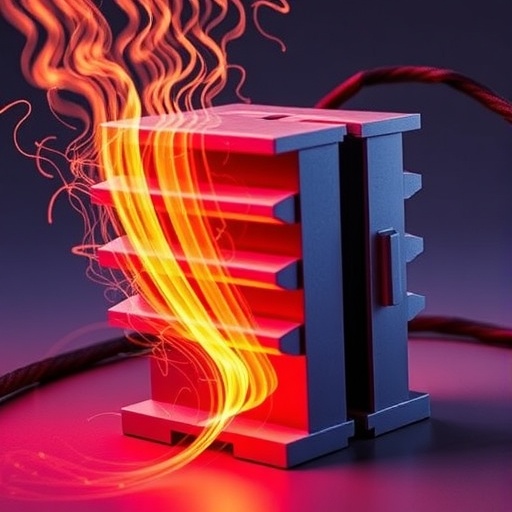In a groundbreaking study published in Scientific Reports, researchers K. Peirens, B. Minnaert, and A. Chevalier embark on a pivotal exploration of bending deformation and its profound implications for capacitive power transfer systems. This research holds the potential to revolutionize how we think about energy transfer in various devices, from electric vehicles to consumer electronics. The manipulation of bending deformation, a phenomenon often overlooked in traditional power transfer systems, could yield significant advancements in energy efficiency and device longevity.
Capacitive power transfer systems, which utilize electric fields to transmit energy wirelessly, are gaining increasing attention in modern technological applications. Their appeal lies in their potential to eliminate cumbersome wires and connectors, providing a seamless energy supply to devices. However, the performance of these systems is considerably influenced by mechanical stress and deformation. The authors meticulously analyze how these physical changes impact efficiency and signal integrity, thereby addressing a crucial gap in the existing body of knowledge on capacitive power transfer.
In this comprehensive study, the authors emphasize the importance of understanding the interaction between mechanical deformations and electrical performance. Bending, stretching, or compressing materials used in capacitive couplings can drastically alter the electric field distribution. This alteration can lead to unexpected losses in power or even complete failure of the system. The research introduces advanced simulation techniques that model these interactions with a high degree of precision, allowing for a deeper insight into the physical principles at play.
The methodology employed by Peirens and colleagues combines theoretical approaches with experimental validations. By fabricating custom capacitive power transfer prototypes, they subjected these systems to various bending conditions, monitoring changes in efficiency and electric field strength. Their results indicate that even minimal bending can lead to significant losses, emphasizing the need for more resilient designs in future capacitive systems. This approach is not only innovative, but it also sets a higher standard for ongoing research in this critical area of technology.
One of the standout findings of this research is the realization that different materials respond differently under mechanical stress. The authors conducted extensive tests on various dielectric materials, each exhibiting unique behaviors when subjected to bending. This discovery highlights the importance of material selection in the design of capacitive power transfer systems; engineers must now consider mechanical properties as a primary factor rather than merely focusing on electrical performance.
The implications of these findings are far-reaching. For example, in automotive applications, where capacitive power transfer systems may be used for wireless charging, the deformation due to vehicle movement and temperature changes becomes crucial. The study addresses how dynamic environments can impose strains on power transfer capabilities, thereby informing future designs in electric vehicle systems to be more robust and efficient.
Furthermore, the researchers delve into potential solutions to mitigate the effects of bending deformation. By optimizing the geometry of the capacitive plates and adjusting the spacing, they found ways to preserve efficiency despite mechanical stress. These design improvements suggest that it is possible to create systems that maintain high performance even under less-than-ideal conditions, a desirable characteristic for real-world applications.
Peirens, Minnaert, and Chevalier’s work also stimulates further research avenues. The coupling of advanced materials, like flexible electronics, with robust design strategies could set a new horizon for capacitive power systems. As wearable technology becomes more prevalent, the demand for lightweight, efficient power sources is paramount. This study offers foundational insights into achieving that goal.
In the context of growing concerns over energy consumption and sustainability, this research contributes significantly to the field of energy technology. By enhancing the efficiency of capacitive power transfers, we can support the shift towards greener technologies that minimize power loss in wireless energy transmission. Consequently, this reinforces the crucial link between academic research and real-world energy solutions.
The authors’ meticulousness in documenting each stage of their experiment aids in establishing transparency and reproducibility, qualities that are essential in scientific research. This level of detail ensures that other researchers can build upon their findings, ultimately fostering a collaborative spirit within the scientific community that drives innovation.
As the research community continues to grapple with complex energy challenges, studies such as this underscore the importance of interdisciplinary approaches. By merging concepts from materials science, engineering, and physics, Peirens and his team exemplify how collaborative efforts can yield transformative insights into energy transfer mechanisms.
Ultimately, the work presented by K. Peirens, B. Minnaert, and A. Chevalier serves as a beacon for future advancements in capacitive power transfer systems. As our reliance on wireless energy increases, understanding the nuances of how physical changes influence performance is paramount. This research is not just a contribution to academic literature; it is a stepping stone toward more efficient, sustainable energy technologies.
In conclusion, the impact of bending deformation on capacitive power transfer systems cannot be overstated. This study lays the groundwork for new designs that prioritize both efficiency and durability. As technology continues to evolve, the insights gained from this research will undoubtedly play a pivotal role in shaping the future of energy transfer solutions in our increasingly connected world.
Subject of Research: Impact of bending deformation on capacitive power transfer systems.
Article Title: Impact of bending deformation on a capacitive power transfer system.
Article References:
Peirens, K., Minnaert, B. & Chevalier, A. Impact of bending deformation on a capacitive power transfer system.
Sci Rep (2025). https://doi.org/10.1038/s41598-025-29265-y
Image Credits: AI Generated
DOI:
Keywords: capacitive power transfer, bending deformation, energy efficiency, wireless charging systems, dielectric materials, electric vehicles, sustainable energy technology.




